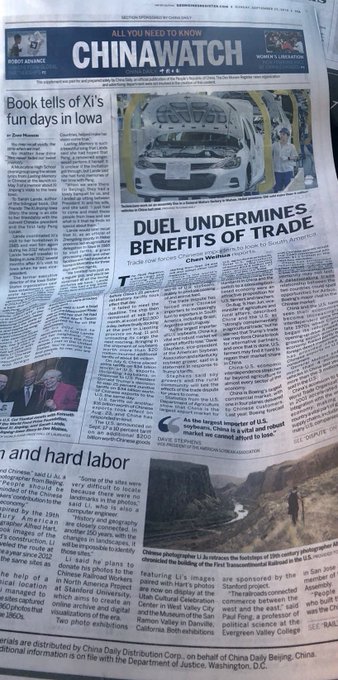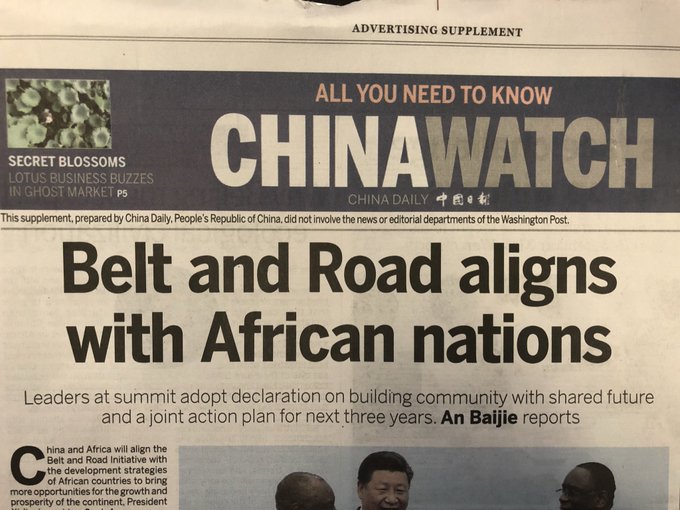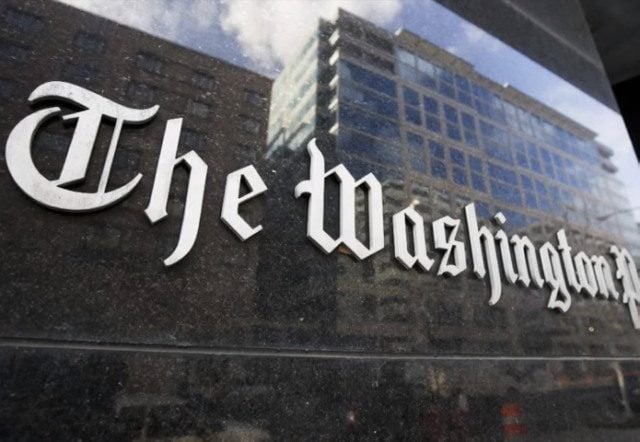US Newspapers Have Received $19 Million from Chinese Propaganda Outlet
If you’ve never read China Daily, you’re missing out.
I’m not saying the news coverage is anything special. Far from it. Click any random story on the China Daily website and it’ll basically read like something from the English version of the pamphlet for the celebration of the Glorious Sixth Anniversary of the Fortuitous Microchip Advancement Without Any IP Theft We Swear to God Stop Accusing Us of That.
However, that’s the beautiful thing. China Daily is part of Beijing’s propaganda mill and reads every bit like you think it would, particularly since it’s in English and doesn’t exactly feel like it’s the Communist Party’s flagship publication.
Here’s a summation of the average article: Picture writing about George Carlin’s comedy while pretending he didn’t swear and not using any swear words yourself (especially those seven). Then picture writing about it in German. Then picture being the kind of person assigned to the fifth-string team for authoring the rushed book “Carlin in Deutsch mit Nein Schwören.” That’s where China Daily fits in the Chinese propaganda firmament.
As much as I love the publication, I wouldn’t give it money. I certainly wouldn’t take money from China Daily. Nor, in fact, would my editors, one of whom takes a certain pride in the fact that his Mandarin is good enough that he’s gotten banned from commenting on its accounts on at least one platform (I don’t pry as to how many he’s up to).
So imagine if you’re The New York Times. Or The Washington Post. Or The Wall Street Journal. Same thing minus editors trolling them, right?
Well, not exactly.
“China Daily, an English-language newspaper controlled by the Chinese Communist Party, has paid more than $4.6 million to The Washington Post and nearly $6 million to The Wall Street Journal since November 2016,” the Daily Caller reported last week.
It has paid more than $19 million to U.S. newspapers in total, the report said.
“Both newspapers have published paid supplements that China Daily produces called ‘China Watch,'” the Daily Caller reported. “The inserts are designed to look like real news articles, though they often contain a pro-Beijing spin on contemporary news events.
“One insert from September 2018 touted an initiative pushed by Chinese President Xi Jinping with the headline: ‘Belt and Road aligns with African nations.’ The same insert ran a story titled ‘Tariffs to take toll on U.S. homebuyers’ that asserted that U.S. tariffs on Chinese lumber would raise the cost of building homes in the United States.”
Hey, at least they’re … um. Oh, Lordy, why would you ever do this?
But wait, it gets better. And by better, I of course mean worse.
And here’s what it looks like:
China Watch appears as an insert in the Washington Post sometimes too. It's labeled an "advertising supplement." ALSO, Russia actually placed propaganda in Americans' newsfeeds made to look like news, and it was not marked as an advertising supplement. twitter.com/realDonaldTrum…
Here’s China Watch from today’s Post. It says “Advertising Supplement” at the top and that it was “prepared by China Daily, People’s Republic of China” and “did not involve the news or editorial departments of the Washington Post.”
See Hunter Schwarz's other Tweets
This is “China Watch,” an “advertising supplement” to The Washington Post. It’s “advertising” for a regime that’s killed a few people over the years, yet no one at The Post saw fit to say anything about this.
The Post’s excuse should probably be that it’s not just The Post.
The pro-democracy organization Freedom House notes that there’s the “periodic inclusion of a paid news-like advertising supplement from China Daily called China Watch in the print editions of papers like the Washington Post, the New York Times, the Wall Street Journal, and the Los Angeles Times.
“Similar advertorial inserts have appeared in major newspapers in other parts of the world, including in Spain, the United Kingdom, Australia, Argentina, Peru, Senegal, and India. In the case of the Washington Post and some other publications, China Watch also appears as an online feature, further blurring the lines between Chinese state media content and the host outlet’s own reporting.”
One might say.
The insert bills itself as “prepared by China Daily, People’s Republic of China.”
This isn’t subtle stuff, either, as you might guess from where it originates.
Take China’s much-touted “Belt and Road” initiative, basically a money pit of spending on Third World infrastructure into which Beijing is willing to funnel huge amounts of capital. Then check out the headline on the sample “advertising supplement” to The Post: “Belt and Road aligns with African nations.” Of course it does.
The reason for stuff like this is that it’s either cheap or effective, and this is both.
“A widely used digital television service in Kenya includes Chinese state television in its most affordable package while omitting international news outlets,” Freedom House reported.
“Portuguese television launches a prime-time ‘China Hour’ featuring content from Chinese state media. Chinese diplomats intimidate a cable executive in Washington, DC, to keep New Tang Dynasty Television (NTDTV), a station founded by Chinese Americans who practice Falun Gong, off the air. And a partly Chinese-owned South African newspaper abruptly ends a writer’s column after he discusses repression in China’s Xinjiang region,” Freedom House reported.
The Daily Caller said it “reached out to all three newspapers to ask if they would commit to cease running the paid supplements, given the Chinese regime’s persecution of ethnic and religious minorities, and whether they would disclose how much revenue they received from the Chinese advertisements.
“Neither the NYT nor the WSJ committed to either measure. WaPo did not return the [Daily Caller’s] inquiry.”
The New York Times apparently felt most threatened by the Daily Caller’s “j’accuse,” though, given the extensive response.
“The New York Times covers China thoroughly and aggressively, and at no time has advertising influenced our coverage. In fact, the publication of this story in 2012 on the hidden wealth of the family of China’s prime minister resulted in The Times being blocked on all platforms in mainland China, which continues to this day,” Times Vice President Eileen Murphy said.
“We’re committed to reporting on China, and fund our Chinese-language site and bureaus in Beijing and Shanghai (as well as Hong Kong) at a significant cost,” she continued.
“We also continue to cover China fearlessly. Our recent investigation based on more than 400 pages of leaked internal Chinese documents provided an unprecedented look into the government’s crackdown on ethnic minorities in the Xinjiang region,” Murphy said, adding that this reporting was “core to our mission to seek the truth and help people understand the world.”
“We accept a wide range of advertisements, including those with provocative viewpoints,” said Dow Jones spokesman Steve Severinghaus, speaking on behalf of The Wall Street Journal.
“We require all ads to be clearly and properly identified as such, and, if an ad is advertorial, we add additional labeling to make clear the newsroom was not involved in its content or creation. The varied and divergent views expressed belong to the advertisers.”
At least by the standards of the article, The Post gave the shrug emoji.
Well, whatever. And yes, this stuff is clearly labeled as a supplement, although this isn’t the kind of thing The Post or Times should be running — given its provenance or the fact it comes from the dictatorial word jumble that is the China Daily.
So why do they do it? Money, obviously. But if that’s the reason, I don’t want to hear Tom Hanks rhapsodizing about the finer qualities of The Washington Post. It’s already subsidized enough by Amazon money.
US Newspapers Have Received $19 Million from Chinese Propaganda Outlet
![US Newspapers Have Received $19 Million from Chinese Propaganda Outlet]() Reviewed by Your Destination
on
June 16, 2020
Rating:
Reviewed by Your Destination
on
June 16, 2020
Rating:






No comments